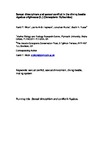Sexual dimorphism and sexual conflict in the diving beetle Agabus uliginosus (L.) (Coleoptera: Dytiscidae)
| dc.contributor.author | Bilton, David | |
| dc.contributor.author | Hayward, JWG | |
| dc.contributor.author | Rocha, J | |
| dc.contributor.author | Foster, GN | |
| dc.date.accessioned | 2017-01-03T15:52:27Z | |
| dc.date.available | 2017-01-03T15:52:27Z | |
| dc.date.issued | 2016-12 | |
| dc.identifier.issn | 0024-4066 | |
| dc.identifier.issn | 1095-8312 | |
| dc.identifier.uri | http://hdl.handle.net/10026.1/8177 | |
| dc.description.abstract |
Sexual conflict can drive intersexual arms races, with female resistance and male persistence traits coevolving antagonistically. Such arms races are well documented in some diving beetles, although the extent of sexual conflict in this family remains unclear. The European dytiscid Agabus uliginosus has a strikingly dimorphic female; individuals from most regions are smooth and male‐like, whereas those from some populations have a strongly roughened dorsum, a trait that has attracted the name dispar. We demonstrate that rough and smooth females differ consistently in the development of dorsal surface microreticulation, and that these females are associated with males that differ in the development of their persistence traits. These findings extend the occurrence of pre‐insemination sexual conflict and associated intrasexual dimorphism in Dytiscidae, and suggest that such mating systems are relatively widespread in these beetles. | |
| dc.format.extent | 1089-1095 | |
| dc.format.medium | Undetermined | |
| dc.language | en | |
| dc.language.iso | en | |
| dc.publisher | Oxford University Press (OUP) | |
| dc.subject | diving beetle | |
| dc.subject | mating system | |
| dc.subject | sexual conflict | |
| dc.subject | sexual dimorphism | |
| dc.title | Sexual dimorphism and sexual conflict in the diving beetle Agabus uliginosus (L.) (Coleoptera: Dytiscidae) | |
| dc.type | journal-article | |
| dc.type | Journal Article | |
| plymouth.author-url | http://gateway.webofknowledge.com/gateway/Gateway.cgi?GWVersion=2&SrcApp=PARTNER_APP&SrcAuth=LinksAMR&KeyUT=WOS:000388505600025&DestLinkType=FullRecord&DestApp=ALL_WOS&UsrCustomerID=11bb513d99f797142bcfeffcc58ea008 | |
| plymouth.issue | 4 | |
| plymouth.volume | 119 | |
| plymouth.publication-status | Published | |
| plymouth.journal | BIOLOGICAL JOURNAL OF THE LINNEAN SOCIETY | |
| dc.identifier.doi | 10.1111/bij.12850 | |
| plymouth.organisational-group | /Plymouth | |
| plymouth.organisational-group | /Plymouth/Faculty of Science and Engineering | |
| plymouth.organisational-group | /Plymouth/Faculty of Science and Engineering/School of Biological and Marine Sciences | |
| plymouth.organisational-group | /Plymouth/REF 2021 Researchers by UoA | |
| plymouth.organisational-group | /Plymouth/REF 2021 Researchers by UoA/UoA07 Earth Systems and Environmental Sciences | |
| plymouth.organisational-group | /Plymouth/Research Groups | |
| plymouth.organisational-group | /Plymouth/Research Groups/Marine Institute | |
| plymouth.organisational-group | /Plymouth/Users by role | |
| plymouth.organisational-group | /Plymouth/Users by role/Academics | |
| dcterms.dateAccepted | 2016-05-06 | |
| dc.rights.embargodate | 2017-6-30 | |
| dc.identifier.eissn | 1095-8312 | |
| dc.rights.embargoperiod | 12 months | |
| rioxxterms.versionofrecord | 10.1111/bij.12850 | |
| rioxxterms.licenseref.uri | http://www.rioxx.net/licenses/under-embargo-all-rights-reserved | |
| rioxxterms.licenseref.startdate | 2016-12 | |
| rioxxterms.type | Journal Article/Review |


